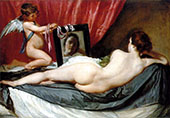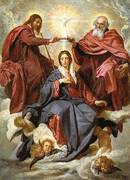Diego Velazquez Oil Painting Reproductions
Diego Velazquez replica paintings on Canvas for sale
Baroque Paintings by Diego Velazquez
Diego Velazquez is one of the most famous Baroque artists. He epitomizes the Spanish Golden Age, producing some of the 17th century’s most imaginative and individual Baroque paintings. Diego Velazquez's paintings portray religious leaders, royal families, and lowly servants. They supply a fascinating insight into the Spanish Royal Court and the artist's progression. Today, we explore the life and times of Diego Velázquez and some of his most famous paintings.
Who is Diego Velazquez?
Born in June 1599, Diego Velazquez spent his early life in Seville, Spain. Aged 11, he started an apprenticeship with a local painter named Francisco Pacheco. However, Velazquez’s talent was clear from even this early age. He often helped Pacheco with Religious Paintings, seeing art by leading Italian Baroque artist Caravaggio. Caravaggio’s pioneering use of chiaroscuro and tenebrism profoundly influenced the young artist. He particularly favored tenebrism, with its violent contrasts between light and dark. Velazquez immediately founded his studio after completing his apprenticeship with Pacheco in 1617. Then, in 1618, he married Juana, Pacheco’s daughter. The couple enjoyed a happy marriage, and Juana gave birth to two daughters in the following few years.
Baroque Paintings by Diego Velazquez
Velazquez was a Spanish Baroque painter. During his early career, Diego Velazquez art often focuses on religious themes. His oil paintings reflect his early training and requests from wealthy patrons. Nonetheless, Velazquez also returned to religious themes in his later career. Mature Religious paintings include Christ Crucified 1632 and the monumental painting Coronation of the Virgin 1645. As his artistic career progressed, Velazquez joined the court of King Philip IV of Spain. This period results in some of the 17th century’s most skillful and extraordinary oil paintings. Velazquez moved to Madrid in 1622. Thanks to Pacheco’s influential connections in high society, he met the Count-Duke of Olivares. He painted the Count’s portrait to significant critical acclaim. As a result, the Count Duke of Olivares introduced Velazquez to King Philip IV of Spain. On seeing some of Velazquez’s portrait paintings, King Philip IV was so impressed that he declared no one else should paint him. Consequently, the King appointed Velazquez as his court painter.
How many Baroque paintings did Diego Velazquez paint?
Throughout his career, Diego Velazquez created between 110 and 120 Baroque paintings. His move to Madrid meant access to King Philip IV’s vast art collection. It also led to introductions with leading artists like Peter Paul Reubens. Indeed, the great Flemish Baroque master spent six months at King Philip’s Court in 1628. His exuberant approach to painting robust, fleshy figures inspired Velazquez. Ruben’s influence appears in many of his paintings of this period, notably The Feast of Bacchus. Velazquez traveled to Italy and discovered Renaissance paintings by Old Masters Leonardo da Vinci, Raphael, and Michelangelo. These Old Master paintings proved another transformative moment for Velazquez and his Baroque paintings.
What is the Famous Portrait by Velazquez?
Velazquez produced many famous portrait paintings during his career. However, his oil painting of Pope Innocent X 1650 is one of his most famous. In 1649, Diego Velazquez traveled to Italy for a second time. During this trip, he gained the opportunity to paint the Pope. Portrait of Pope Innocent X is one of our popular paintings. Diego Velazquez also painted several notable paintings of the Spanish Royal family; Infanta Maria Teresa and Prince Baltasar Carlos are just two. From the 1630s onwards, Velazquez also painted dwarfs serving in the Royal Court. Unusually for artists of the time, he painted these individuals as complex human beings. His psychological insight is particularly evident in works such as The Dwarf Francisco Lezcano 1643. The nude painting by Diego Velazquez, Venus at Her Mirror, is an exceptionally famous oil painting of Baroque period art. It is also known as The Rokeby Venus, as for a major part of the 19th century, the painting was on display at Rokeby Park, a country estate in County Durham in England.
Why is Las Meninas so famous?
Upon leaving Italy, Diego Velazquez rejoined the Royal Spanish Court. From this point forward, his style is even more refined and skillful. His return to Spain resulted in one of his most acclaimed and mysterious artworks. The painting was, of course, Las Meninas 1656. Today, Velazquez Las Meninas painting is still one of the most famous artworks in the world. It is renowned for its masterful painterly technique and mysterious composition. Indeed, this oil painting presents a moment frozen in time, focusing on the Infanta Margarita Theresa. Margarita Theresa was the King’s only surviving heir when the painting was created.
Diego Velázquez peers out from the canvas but is partially concealed by a large easel. He is probably studying the Spanish King and Queen for his large portrait painting. Indeed, the King and the Queen appear in a mirror at the back of the composition. Despite this, as a viewer, it seems that Velazquez is studying us. Las Meninas is a clever commentary on the relationships between viewers, sitters, and artistic creators.
Where are Paintings by Velazquez?
Today, Diego Velazquez's paintings appear in leading museums worldwide. These institutions include the Museo del Prado in Madrid, Spain, and the National Gallery in London, England. The Metropolitan Museum in New York, USA, also boasts a substantial collection of Baroque paintings.
In 1658 Philip IV appointed Velazquez as a Knight of Santiago. This prestigious title thanks Velazquez for his work at the Royal Court and his paintings. Velazquez often worked as a court wardrobe assistant and keeper of the Royal Art Collection. His later responsibilities involved decoration for the wedding of Maria Theresa to Louis IV in 1660. Unfortunately, perhaps because of the intense work involved, Diego Velázquez contracted a fever. After the wedding, he returned to Madrid but died two months later, on 6 August 1660. Given his close relationship with Velazquez, his death deeply saddened King Philip IV, who described his emotional state as “crushed.”
Diego Velazquez Museum quality oil paintings on canvas
If you love the mastery and beauty of Diego Velazquez paintings, explore our collection of his most famous Baroque art. Discover fine art replicas to enhance your home or office, from Las Meninas to the striking portrait painting of Pope Innocent X or the sensuality of the Rokeby Venus.
Cannot Find What You Are Looking For?
Reproduction Gallery Information
Customer Service
(Send Us A Message)
Tel: (503) 937 2010
Fax: (503) 937 2011
























